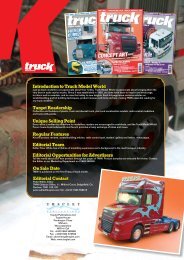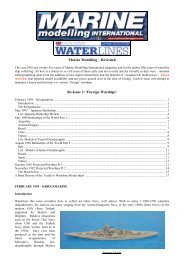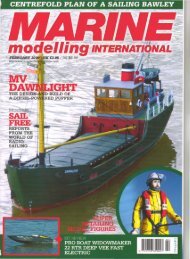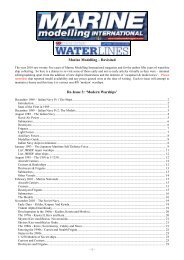Marine Modelling – Revisited Re-Issue 5 - Traplet Publications
Marine Modelling – Revisited Re-Issue 5 - Traplet Publications
Marine Modelling – Revisited Re-Issue 5 - Traplet Publications
You also want an ePaper? Increase the reach of your titles
YUMPU automatically turns print PDFs into web optimized ePapers that Google loves.
An Anglo-Dutch air search radar was planned with a large radome (also intended for CVA01) to be installed on the bridge.<br />
When this was cancelled the Type 965 was adopted (replaced by T1022 in 1984) supplemented by the T992Q for surface<br />
search. Other electronics included the T 978 (later 1006) navigation radar and T170 & T184 sonars. In 1974 the steam<br />
engines were badly damaged by fire and the ship continued on gas turbines alone until 1976. In 1979 she was given some<br />
Corvus chaff launchers and a pair of vintage Oerlikon 20mm guns; at the same time the Limbo was removed and the well<br />
famously used, albeit briefly, as a swimming ‘pool’. In 1982 the pool was plated over providing a larger flight deck and the<br />
ship deployed to the Falklands as escort to HMS Illustrious. In 1983 her close range AA armament was boosted by two<br />
twin Oerlikon/BMARC 30 mm and two single Oerlikon/BMARC 20 mm; SRBOC countermeasures launchers were also<br />
installed. In 1984 the Ikara was removed although plans to fit two triple STWS-1 ASW torpedo launchers failed to<br />
materialise. In 1987 she took over from the County class DLG HMS Kent as the Portsmouth training ship, where she may<br />
be viewed today on a harbour cruise.<br />
Type 42 Destroyer<br />
Providing improved capabilities over the Type 82 but on a smaller (and therefore cheaper) hull, the Type 42 lost Ikara but<br />
added the all important helicopter hangar and the ability to operate and support a Lynx. Designed to strict size limits the<br />
first two ‘batchs’ (aka the ‘stumpies’) came in at circa 413 feet oa and 4,350 tons full load. By the mid 1970s it was<br />
appreciated that a larger hull would confer benefits of sea-worthiness and space for extra equipments and the final batch<br />
(aka ‘stretched’) were 466 feet (and 3 feet wider at 49 feet) on 5,350 tons; later on a hull strengthening strake was fitted<br />
amidships to the Batch 3s. The first of class only – HMS Sheffield - was fitted with exhaust deflectors on the funnel. In the<br />
wake of the Falklands the original sea boats amidships either side<br />
of the funnel were ditched for twin Oerlikon/BMARC 30 mm and<br />
two (some sources say four) single Oerlikon/BMARC 20 mm are<br />
carried. The 30mm themselves were later replaced by the Phalanx<br />
CIWS as can be seen on the ships today. The original Mk 8 gun<br />
has been upgraded and the newer version possesses a unique<br />
chiselled appearance – Kryton to some! In Batches 1 and 2 the Sea<br />
Dart magazine houses 24 rounds with 40 in the Batch 3. Originally<br />
carried were a pair of triple STWS-1 ASW torpedo launchers but<br />
these seem to have been removed from all Batch 1s and 2s.<br />
The original Type 965 and T992Q radars have been superseded by<br />
the T1022 and T996 and these newer radars were first seen on the<br />
Batch 2s but were retro-fitted to the four surviving Batch 1s. Two<br />
HMS Southampton<br />
909 fire control radars are fitted. Other sensors include T1007<br />
navigation radar and Sonar Types 2050, 2016 & 162. All are<br />
propelled by Tyne and Olympus gas turbines giving a top speed of 30 knots from the latter.<br />
Having completed HMS Sheffield, VSEL built a Batch 1 for the Argentine Navy (Armada <strong>Re</strong>publica Argentina) with ARA<br />
Hercules commissioning in July 1976. In parallel a second - Santissima Trinidad - was built over a prolonged period by<br />
AFNE, Rio Santiago finally commissioning in July 1981. Both are thought to be in Puerto Belgrano, but in poor condition;<br />
reportedly the Hercules may still be sea-worthy and has been fitted with a new aft superstructure/hangar and Exocet missile<br />
launchers.<br />
Name Pennant Builder Commissioned Notes<br />
Batch 1<br />
Sheffield D80 VSEL Feb 1975 Sunk in Falklands War<br />
Birmingham D86 Cammell Laird Dec 1976 Sold for Scrap<br />
Newcastle D87 Swan Hunter Mar 1978 Awaiting Disposal<br />
Glasgow D88 Swan Hunter May 1977 Awaiting Disposal<br />
Cardiff D108 VSEL Sep 1979 Awaiting Disposal<br />
Coventry D118 Cammell Laird Oct 1978 Sunk in Falklands War<br />
Batch 2<br />
Exeter D89 Swan Hunter Sep 1980 } all probably<br />
Southampton D90 Vosper Thornycroft Oct 1981 } to be withdrawn<br />
Nottingham D91 Vosper Thornycroft Apr 1983 } from service in 2008<br />
Liverpool D92 Cammell Laird Jul 1982<br />
Batch 3<br />
Manchester D95 VSEL Dec 1982<br />
Gloucester D96 Vosper Thornycroft Sep 1985<br />
Edinburgh D97 Cammell Laird Dec 1985<br />
York D98 Swan Hunter Aug 1985<br />
List: Type 42 Destroyers<br />
- 11 -







